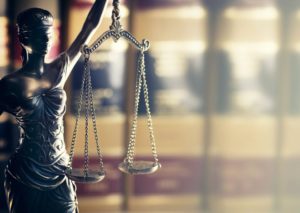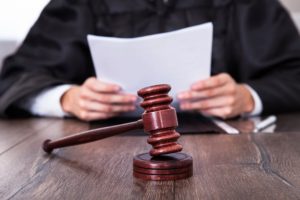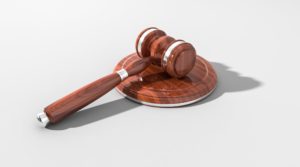By Hailey Cleek & Raquel Macgregor
On November 6th, the Fourth Circuit granted a hearing en banc to review President Trump’s third Executive Order iteration on immigration. The new Presidential Proclamation (“Proclamation”), like its predecessors, restricts immigration from several Muslim-majority countries. The case was appealed to the Fourth Circuit after the District Court of Maryland granted in part a preliminary injunction blocking the new Proclamation.[1] Given the past Fourth Circuit and Supreme Court rulings blocking President Trump’s first two Executive Orders, the Fourth Circuit is likely to affirm the injunction in part.
The Fourth Circuit Struck Down the Previous Executive Order
In March of 2017, the Fourth Circuit largely upheld the Maryland District Court’s ruling blocking implementation of an Executive Order signed by President Donald Trump.[2] In the Executive Order, the Trump Administration had temporarily suspended new visas for travelers from six Muslim-majority countries for ninety days and the admission of new refugees into the United States for 120 days.[3] The Fourth Circuit held that the Executive Order violated the Establishment Clause because it was motivated by a discriminatory animus toward Muslims.[4] The Supreme Court then granted certiorari and partially stayed the injunction. Furthermore, because the Fourth Circuit Order had expired by “its own terms” on September 24, 2017, the Supreme Court vacated the judgment, as the appeal no longer presented a “live case or controversy.”[5]
The New Presidential Proclamation
On September 27, 2017, President Trump issued a new Presidential Proclamation. This Proclamation keeps restrictions on five of the six original countries (Iran, Libya, Somalia, Syria, and Yemen), lifts restrictions on visitors from the Sudan, and adds new restrictions on visitors and immigrants from Chad, North Korea, and Venezuela.[6] In both previous executive orders, all banned countries were majority Muslim. However, the Proclamation now includes two non-majority Muslim countries: North Korea and Venezuela.[7]
The new restrictions vary by country. Immigrants and nonimmigrants from Chad, Libya, and Yemen are barred from entry into the United States, on business, tourism, or through business-tourist visas.[8] Likewise, Iranian citizens are barred from entry with an exception for students, provided that they receive extra screening.[9] The Proclamation also bars immigrants and nonimmigrants from North Korea and Syria as well as immigration by citizens of Somalia.[10] Yet, the restrictions placed on Venezuela only impacts Venezuelan government officials and their families.[11]
Despite the changes to the immigration order, the Maryland District Court enjoined Section 2 of the Proclamation. In order to obtain a preliminary injunction, plaintiffs must show that: “(1) they are likely to succeed on the merits, (2) they are likely to suffer irreparable harm in the absence of preliminary relief, (3) the balance of equities tip in their favor, and (4) the injunction is in the public interest.”[12] The district court ultimately found that Plaintiffs were likely to succeed on their Establishment Clause claim and that the Proclamation likely violates §1152(a) of the Immigration and Nationality Act (“INA”) which prohibits discrimination based on nationality in issuing immigrant visas. Yet, the court found that the balance of equities only allowed enjoining the Proclamation on behalf of “individuals ‘who have a credible claim of a bona fide relationship with a person or entity in the United States.’”[13] Thus, the injunction bars the Proclamation’s impact on individuals with immediate family members in the United States. Moreover, the injunction does not apply to individuals traveling from Venezuela or North Korea as Plaintiffs have not demonstrated how individuals from those countries with a bona fide relationship with the United States will be harmed.
Arguments for Upholding the Presidential Proclamation
In the appellant’s opening brief, the government argues that the district court abused its discretion in granting a preliminary injunction because the President’s actions are not subject to judicial review and the elements required to grant a preliminary injunction are not satisfied. Regarding justiciability, the government contends that a denial of a visa is not subject to judicial review.[14] Yet, this argument blatantly ignores that the Supreme Court allowed judicial review of the past two executive orders.[15]
However, the government focuses its brief on its likelihood of success on the merits under both the plaintiff’s statutory and constitutional claims. First, the government argues that the Proclamation is consistent with the INA because the President has broad discretion to suspend entry of aliens whenever they “would be detrimental to the interests of the United States” under 8 U.S.C. §1182(f).[16] The government contends that 8 U.S.C. §1152(a)(1)(A), which prohibits discrimination of nationality in the issuance of immigrant visas, does not in fact conflict with the President’s broad discretion.[17] Instead, the government dubiously claims that the prohibition against nationality discrimination only applies after the President has full discretion to “limit the universe of individuals eligible to receive visas,”[18] which would effectively render §1152(a)(1)(A) meaningless.
The largest hurdle President Trump will face is convincing the court that the purpose of this Proclamation differs from his previous executive orders. In response to plaintiff’s establishment claim, the government claims that because the ban no longer targets only Muslim-majority countries (given the addition of North Korea and Venezuela), the purpose behind the Proclamation is to protect the United States from terrorism. The Proclamation asserts that it has singled out Chad, Iran, Libya, North Korea, Syria, Venezuela, Yemen, and Somalia after a “global review” by the Department of Homeland Security (“DHS”) and Department of State which identified these countries as having “inadequate practices or otherwise present heightened risks.”[19] Thus, by relying on the DHS review, the Proclamation has distinguished itself from previous travel limitation executive orders. Yet, this argument will likely face significant criticism given that the Proclamation included Somalia, a majority Muslim country, in its list of restricted countries even though the DHS report deemed the country to have adequate information-sharing practices.[20]
Arguments against the Presidential Proclamation
Plaintiffs assert that the Proclamation violates various provisions of the INA.[21] Primarily, plaintiffs argue that the Proclamation violates § 1152(a) of the INA,[22] which bars discrimination on the basis of nationality in the issuance of immigrant visas. Specifically, §1152(a) provides that, with certain exceptions: “No person shall receive any preference or priority or be discriminated against in the issuance of an immigrant visa because of his race, sex, nationality, place of birth, or place of residence[.]”[23] The Maryland District Court already considered the “interplay” between § 1182(f) and § 1152(a) and concluded that the President’s authority under § 1182(f) is limited by the § 1152(a) bar on discrimination based on nationality in the issuance of immigrant visas.[24] While the government could argue that the suspension of entry is not analogous to the issuance of visas, Judge Thacker of the 4th Circuit has already suggested that this argument will not be successful.[25] Here, unlike previous travel limitations used by both Presidents Reagan and Carter, the Proclamation has no end date and no requirement of renewal.[26] This creates a permanent ban on immigration from the Designated Countries, thus stopping the issuance of immigrant visas indefinitely. Thus, the bar on entry is equivalent to a ban on issuing immigrant visas based on nationality. Moreover, the Ninth Circuit found that the executive order violated the INA’s prohibition on nationality-based discrimination in the issuance of immigrant visas.[27] Consequently, plaintiffs are likely to succeed on their claim that the Proclamation violates § 1152(a) non-discrimination.
Plaintiffs argue that the Proclamation violates the Establishment Clause. Citing Larson v. Valente, the plaintiffs contend that the “primary effect” of the Proclamation “burden[s] . . . [a] selected religious denomination” through its immigration restrictions which overwhelmingly impact Muslims.[28] Moreover, under the Lemon v. Kurtzman[29] framework, to withstand an Establishment Clause challenge: (1) an act must have a secular purpose, (2) “its principal or primary effect must be one that neither advances nor inhibits religion,” and (3) it must not “foster ‘an excessive government entanglement with religion.’”[30] Challengers argue that this new Proclamation, similar to the last two executive orders, is primarily motivated by religious intolerance. Despite the “changed nomenclature” and selective inclusions of agency recommendations, the very first line of the order identifies the Proclamation as an “outgrowth” of the previous Executive Order attempts to limit travel.[31] Moreover, the Trump administration’s public statements about the new Proclamation indicate that it is the same in substance to the previous executive orders and that changes are “mostly minor technical differences.”[32] Plaintiffs in the Fourth Circuit highlight that “contours of the ban” still reflect a “religious ‘gerrymander.’”[33] Thus, Plaintiffs will argue that the Proclamation is still animated by the desire to ban Muslims, violating the Establishment Clause’s commend that the Government not target or disfavor people based on their religion.
Lastly, the government’s own delay in implementing the Proclamation spurs skepticism. The Trump administration has repeatedly emphasized the need for immediate action in crafting the travel bans.[34] The Proclamation details that the President “act[s] to protect the security and interests of the United States and its people.”[35] Yet, despite the government’s claims for urgency in halting travel, the Executive Order deferred implementation of the bulk of its restrictions for almost a month.[36] Thus, the government has undermined its own claims of urgency by delaying implementation while still not correcting deficiencies that made prior orders unlawful.
Conclusion
The Fourth Circuit is likely to side with Plaintiffs in granting an injunction in part given both the district court’s preliminary injunction as well as the Fourth Circuit and Supreme Court’s past partial injunctions. While the newest rendition of the ban attempts to distance itself from the religious animus that motivated the first two Executive Orders, the new Proclamation is largely still motivated by a non-secular purpose. Following the language of the Supreme Court, the Fourth Circuit’s decision will likely center on whether individuals from the Designated Countries have a “credible claim of a bona fide relationship with a person or entity in the United States.”[37] Thus, the Fourth Circuit will likely enjoin the Proclamation from barring entry to individuals that have immediate family members in the United States.
_______________
[1] Presidential Proclamation No. 9645, 82 Fed. Reg. 45161 (Sept. 27, 2017).
[2] Int’l Refugee Assistance Project v. Trump, 857 F.3d 554, 557 (4th Cir. 2017), vacated No. 16-1436, 2017 WL 4518553.
[3] Exec. Order No. 13,780, 82 Fed. Reg. 13209 (Mar. 9, 2017).
[4] Int’l Refugee Assistance Project v. Trump, 857 F.3d 554, 557 (4th Cir. 2017).
[5] See Trump v. Int’l Refugee Assistance Project, No. 16-1436, 2017 WL 4518553, at *1 (Oct. 10, 2017).
[6] Pete Williams, Trump Restricts Visas From Eight Countries as Travel Order Expires, NBC News (Sept. 25, 2017, 8:35 AM), https://www.nbcnews.com/politics/immigration/trump-restricts-visas-eight-countries-travel-order-expires-n804366.
[7] See Proclamation, supra note 1.
[8] Id.
[9] Id.
[10] Id.
[11] Id.
[12] Int’l Refugee Assistance Project v. Trump, No. CV TDC-17-0361, 2017 WL 4674314, at *40 (D. Md. Oct. 17, 2017).
[13] Id. at *88; see Trump v. Int’l Refugee Assistance Project, 137 S. Ct. 2080, 2088 (2017).
[14] First Cross-Appeal Brief for Appellants at 19, Int’l Refugee Assistance Project v. Trump, No. 17-2231 (4th Cir. Nov. 1, 2017).
[15] See generally Trump v. Int’l Refugee Assistance Project, 137 S. Ct. 2080 (2017).
[16] First Cross-Appeal Brief for Appellants at 19, Int’l Refugee Assistance Project v. Trump, No. 17-2231 (4th Cir. Nov. 1, 2017).
[17] Id. at 34-35.
[18] Id. at 35.
[19] Id. at 1.
[20] Int’l Refugee Assistance Project v. Trump, No. CV TDC-17-0361, 2017 WL 4674314, at *78 (D. Md. Oct. 17, 2017).
[21] First Cross-Appeal Brief for Appellees at 23, Int’l Refugee Assistance Project v. Trump, No. 17-2231 (4th Cir. Nov. 1, 2017).
[22] 8 U.S.C. § 1152(a) (2012).
[23] 8 U.S.C. § 1152(a)(1)(A) (2012).
[24] Int’l Refugee Assistance Project v. Trump, No. CV TDC-17-0361, 2017 WL 4674314, at *20 (D. Md. Oct. 17, 2017).
[25] Int’l Refugee Assistance Project v. Trump, 857 F.3d 554, 637 (4th Cir. 2017), (Thacker, J., concurring) (“Here, the ultimate effect of what EO–2 actually does is require executive agencies to deny visas based on nationality.”).
[26] Int’l Refugee Assistance Project v. Trump, No. CV TDC-17-0361, 2017 WL 4674314, at *21 (D. Md. Oct. 17, 2017).
[27] Hawaii v. Trump, 859 F.3d 741, 774, 779 (9th Cir. 2017).
[28] First Cross-Appeal Brief for Appellees at 53, Int’l Refugee Assistance Project v. Trump, No. 17-2231 (4th Cir. Nov. 1, 2017) (quoting Larson v. Valente, 456 U.S. 228, 255 (1982).
[29] 403 U.S. 602 (1971).
[30] Id. at 612–13.
[31] See Appellee’s Opposition to Motion to Stay at 4, Hawaii v. Trump, (9th Cir. 2017) (No. 17-17168); see Proclamation, supra note 1.
[32] Int’l Refugee Assistance Project v. Trump, No. CV TDC-17-0361, 2017 WL 4674314, at *70 (D. Md. Oct. 17, 2017).
[33] First Cross-Appeal Brief for Appellees at 53, Int’l Refugee Assistance Project v. Trump, No. 17-2231 (4th Cir. Nov. 1, 2017) (quoting Church of the Lukumi Babalu Aye, Inc. v. City of Hialeah, 508 U.S. 520, 533–35, 538 (1993)).
[34] See Donald Trump (@realDonaldTrump), Twitter (June 3, 2017, 7:17 P.M.), https://twitter.com/realDonaldTrump/status/871143765473406976 (“We need the courts to give us back our rights. We need the Travel Ban as an extra level of safety!”); Aric Jenkins, Sean Spicer Says President Trump Considers His Tweets ‘Official’ White House Statements, Time (June 6, 2017), http://time.com/4808270/sean-spicer-donald-trump-twitter-statements (Former Press Secretary Sean Spicer has previously stated that the President’s tweets should be considered official statements).
[35] Proclamation, supra note 1.
[36] See id. (The Proclamation was announced on September 27th, yet many of the restrictions were not set to take effect until October 18th.).
[37] Trump v. Int’l Refugee Assistance Project, 137 S. Ct. 2080, 2088 (2017).






